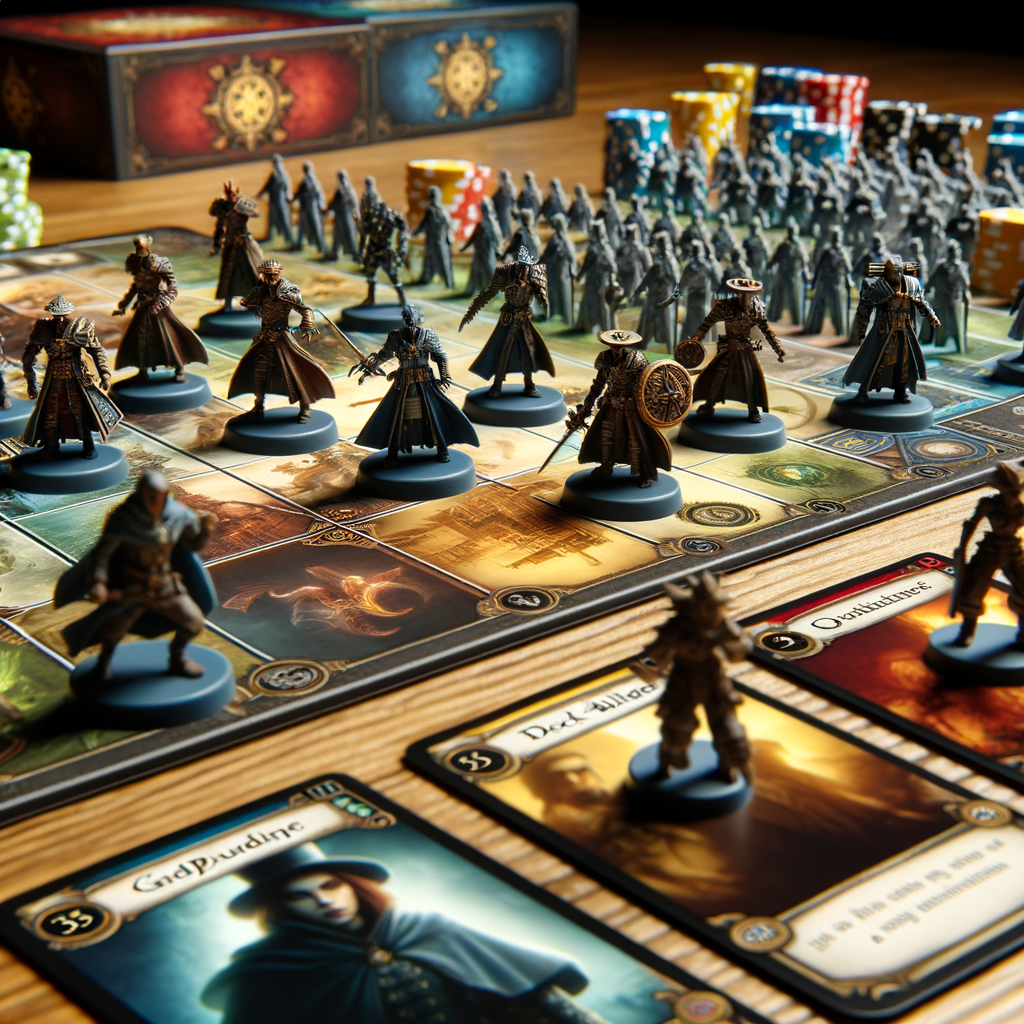Introduction to Miniatures in Board Games
Board games have been a source of entertainment for centuries, evolving over time to include various elements that enhance the gaming experience. One such element is the use of miniatures. In this section, we will delve into the world of miniatures in board games, exploring their definition, history, and impact on the gaming experience.
- Definition and history of miniatures in board games
Miniatures, often referred to as minis, are small, detailed figures used in board games to represent characters, creatures, or objects. The use of miniatures in board games dates back to the 19th century, with games like ‘The Mansion of Happiness’ using small, carved wooden pieces. Over time, these evolved into intricately designed, often hand-painted, plastic or metal figures that add a visual appeal to the game. (source)
- Impact of miniatures on the gaming experience
Miniatures can significantly enhance the gaming experience. They add a tactile and visual element to the game, making it more immersive and engaging. Players can physically move their characters around the game board, adding a sense of realism and depth to the gameplay. Moreover, beautifully crafted miniatures can be a source of pride for gamers, with some even collecting them as a hobby. The use of miniatures can also aid in understanding the game mechanics, as they provide a clear, visual representation of the game’s elements.
In the following sections, we will delve deeper into the mechanics of board games, explore a popular miniature deck-building game, and provide tips and tricks for mastering these games. So, whether you’re a seasoned gamer or a novice looking to dive into this fascinating world, stay tuned for an exciting journey into the realm of miniature board games.
Understanding Deck-Building Mechanics
Deck-building mechanics are a fundamental part of many board games. To fully appreciate and master these games, it’s important to understand what deck-building mechanics are and the role they play. Let’s delve into these aspects.
- Definition of deck-building mechanics
Deck-building mechanics refer to the game rules and strategies that involve players creating and managing their own set of cards (or ‘deck’) throughout the game. This mechanic was first introduced in the game Dominion and has since been used in many other games. The deck represents resources, actions, or points that players can use to achieve the game’s objectives. The unique aspect of deck-building games is that each player’s deck is personal and can change and evolve during the game based on their decisions.
- Role of deck-building mechanics in board games
Deck-building mechanics play a crucial role in board games. They add a layer of strategy and personalization, as each player can build and adapt their deck according to their preferred play style or the game’s changing circumstances. This mechanic also introduces an element of unpredictability, as the cards drawn from the deck can vary each turn, requiring players to continually adapt their strategies. Furthermore, deck-building mechanics can enhance a game’s replayability, as the multitude of possible deck combinations can make each game feel unique.
In conclusion, understanding deck-building mechanics can greatly enhance your board game experience. Whether you’re strategizing to optimize your deck or adapting to the luck of the draw, these mechanics add depth and excitement to the game.
Unmatched Game Review: A Miniature Deck-Building Game
Today, we delve into the exciting world of the Unmatched board game, a unique blend of miniature and deck-building gameplay. This review will provide an overview of the game, analyze its deck-building mechanics, and evaluate the miniature elements that make it stand out.
Overview of Unmatched Board Game
The Unmatched board game is a highly engaging, competitive game that combines strategic deck-building with dynamic miniature gameplay. Players choose from a variety of historical and mythical characters, each with their unique deck and miniature. The objective is to outsmart and outmaneuver your opponents, using your deck and miniature strategically to achieve victory. The game is designed for 2-4 players and typically lasts between 20-40 minutes, making it a perfect choice for game nights.
Analysis of the Game’s Deck-Building Mechanics
Unmatched’s deck-building mechanics are at the heart of its gameplay. Each character has a unique deck of cards that represents their abilities and tactics. Players must strategically use their cards to attack, defend, and maneuver on the game board. The deck-building aspect of Unmatched is not about building your deck during the game but rather about strategically using the deck you’re given. This mechanic adds a layer of depth and strategy, making every game a unique experience.
Review of the Miniature Elements in the Game
The miniature elements in Unmatched add a tangible, visual aspect to the game. Each character is represented by a beautifully crafted miniature figure, bringing the game to life on the board. These miniatures are not only aesthetically pleasing but also serve a functional purpose, representing characters’ positions and movements on the board. The quality and detail of these miniatures significantly enhance the overall gaming experience.
In conclusion, Unmatched is a captivating game that successfully combines deck-building and miniature gameplay. Its unique mechanics and beautifully crafted miniatures make it a must-have for any board game enthusiast.
Exploring Board Game Mechanics
Board games are a delightful blend of strategy, chance, and creativity. One of the most engaging aspects of these games is the variety of mechanics they employ. In this section, we will delve into the fascinating world of deck-building strategy, a popular mechanic in many board games.
Deck-Building Strategy
Deck-building is a game mechanic where players start with a small deck of cards and gradually improve their deck over the course of the game. This mechanic introduces a unique blend of strategy and luck, as players must decide which cards to add to their deck while also contending with the randomness of the draw.
- Importance of strategy in deck-building games
Strategy plays a crucial role in deck-building games. It’s not just about collecting the most powerful cards, but also about how well you can use them together. A well-crafted deck can give you a significant advantage over your opponents. According to a Wikipedia article, the strategy in deck-building games often revolves around creating powerful combinations of cards that work well together.
- Common strategies employed by players
There are several strategies players often employ in deck-building games. Some players focus on acquiring a few powerful cards, while others aim to create a large deck with many different options. Some common strategies include:
- Engine Building: This strategy involves acquiring cards that work well together to create powerful combinations.
- Card Cycling: This strategy focuses on quickly going through your deck to get to your most powerful cards faster.
- Deck Thinning: This strategy involves removing weaker cards from your deck to increase the chances of drawing your stronger cards.
Understanding and mastering the deck-building strategy can greatly enhance your board game experience. It adds a layer of depth and complexity that makes each game unique and exciting.
Miniature Game Design
Designing miniature games is both an art and a science. It involves the careful crafting of small-scale models and game mechanics to create an engaging and enjoyable gaming experience. Let’s delve into the role of design in these games and its impact on player engagement.
- Role of Design in Miniature Games
The design of a miniature game is crucial to its success. It’s not just about creating visually appealing miniatures. The design also has to consider the game’s mechanics, rules, and overall gameplay. The goal is to create a game that is easy to understand, but also offers depth and complexity for those who want to explore it further.
For example, in the popular miniature game Warhammer 40,000, the design of the miniatures and the game board contribute to the immersive experience. The intricate details of the miniatures and the realistic terrain of the game board make players feel like they are commanding real armies in a futuristic battlefield. Learn more about Warhammer 40,000 on Wikipedia.
- Impact of Design on Player Engagement
The design of a miniature game can significantly impact player engagement. A well-designed game can captivate players, keep them engaged for hours, and even encourage them to invest in more miniatures and expansions.
Take, for instance, the game Star Wars: X-Wing Miniatures Game. The game’s design, which includes highly detailed miniatures of iconic Star Wars ships and a unique maneuvering system, has garnered a large and dedicated player base. The design not only engages players during the game but also encourages them to collect more miniatures and participate in tournaments. Read more about Star Wars: X-Wing Miniatures Game on Wikipedia.
In conclusion, the design of a miniature game plays a vital role in its success. It not only contributes to the game’s visual appeal but also impacts the gameplay and player engagement. A well-designed miniature game can offer an immersive and engaging experience that keeps players coming back for more.
Intrigue in Miniature Gaming: Case Studies
Let’s dive into the fascinating world of miniature gaming by exploring two intriguing case studies. These studies will provide a deeper understanding of the mechanics and strategies involved in these games.
Case study 1: Unmatched Board Game
The Unmatched Board Game is a prime example of a miniature deck-building game that has captured the hearts of many players. It combines the thrill of strategic card play with the tactile appeal of high-quality miniatures.
One of the key aspects that make Unmatched stand out is its unique character abilities. Each character has a deck of cards that not only represents their health but also their special abilities and attacks. This mechanic adds a layer of strategy and unpredictability to the game, keeping players on their toes.
Statistics show that Unmatched has a high replayability rate, with players often engaging in multiple rounds in a single sitting. This is a testament to the game’s engaging mechanics and the intrigue it generates.
Case study 2: Another popular miniature deck-building game
Another popular miniature deck-building game that has made waves in the gaming community is Star Realms. This game combines the excitement of deck-building with the strategic depth of a space combat game.
Star Realms is unique in its approach to deck-building. Players start with a small deck of ships and bases, and over the course of the game, they acquire new and more powerful cards to add to their deck. The goal is to build a deck powerful enough to destroy your opponent’s bases while protecting your own.
Star Realms has been praised for its balance and depth, with players appreciating the strategic decisions they have to make each turn. The game’s popularity is reflected in its sales figures, with over a million copies sold worldwide.
These case studies highlight the intrigue and strategic depth that miniature deck-building games can offer. They demonstrate how these games are not just about the miniatures, but also about the intricate mechanics and strategies that players must navigate to win.
Deck-Building Game Techniques: Tips and Tricks
Mastering the art of deck-building games is no small feat. It requires a blend of strategic thinking, careful planning, and the ability to adapt to changing circumstances. In this section, we’ll explore three key techniques that can help you elevate your game: card selection, deck management, and adapting to your opponents’ strategies.
- Technique 1: Card selection
Card selection is the cornerstone of any successful deck-building strategy. The cards you choose to include in your deck will determine the tactics and strategies you can employ during the game. It’s important to select cards that synergize well with each other and align with your overall game plan. For example, if your strategy revolves around dealing direct damage to your opponent, cards that enhance or multiply this damage would be a good fit for your deck.
- Technique 2: Deck management
Deck management involves carefully controlling the size and composition of your deck. A common mistake among beginners is to include too many cards in their deck, which can lead to inconsistency and unpredictability. A smaller, more focused deck is often more effective. Remember, every card you add to your deck should serve a specific purpose and contribute to your overall strategy.
- Technique 3: Adapting to opponents’ strategies
In deck-building games, the ability to adapt to your opponent’s strategies is crucial. This involves anticipating their moves, countering their strategies, and adjusting your game plan on the fly. Pay close attention to the cards your opponent plays and try to deduce their overall strategy. This will allow you to make informed decisions about which cards to play and when to play them.
By mastering these techniques, you can gain a significant edge over your opponents and increase your chances of victory. Remember, practice makes perfect, so don’t be discouraged if you don’t see immediate results. Keep refining your strategies, learning from your mistakes, and you’ll soon see improvement in your game.
Conclusion: The Future of Miniature Deck-Building Games
As we draw to a close, let’s take a look at the future of miniature deck-building games. This genre of board games has seen a significant rise in popularity over the years, and it’s exciting to anticipate what the future holds. We’ll explore the current trends and make some predictions about what’s to come.
- Trends in the world of miniature deck-building games
One of the key trends in miniature deck-building games is the increasing use of technology. Many game developers are incorporating digital elements into their games, such as apps that can be used to enhance gameplay. For example, the game Unmatched has an accompanying app that provides additional game scenarios and tracks player progress.
Another trend is the growing diversity in game themes and characters. Games are becoming more inclusive, featuring characters from a wide range of backgrounds and cultures. This not only makes the games more interesting and varied, but also more appealing to a broader audience.
- Future predictions for the genre
Looking ahead, we predict that the genre of miniature deck-building games will continue to grow and evolve. With advancements in technology, we can expect to see more games that blend physical and digital gameplay. This could include more use of augmented reality (AR) and virtual reality (VR) in games.
We also anticipate a continued push towards more inclusive and diverse games. As the gaming community becomes more aware of the need for representation, we expect to see more games that reflect the diversity of its players.
Finally, we predict that there will be a greater emphasis on creating games that are not only fun to play, but also educational. Games can be a great way to learn new skills or knowledge, and we expect to see more games that leverage this potential.
In conclusion, the future of miniature deck-building games looks bright and exciting. With new trends emerging and predictions of continued growth, there’s never been a better time to be a fan of this genre. Whether you’re a seasoned player or new to the world of deck-building games, there’s plenty to look forward to.




